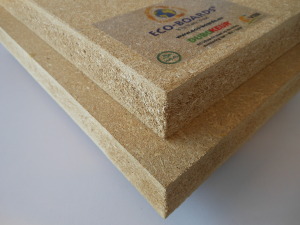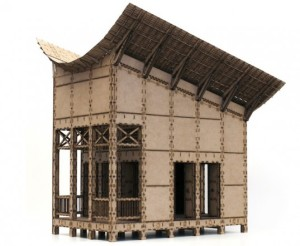ECOBoard Softboard
Key features:
- INSULATING board with structural strength
- Excellent strength to weight performance
- Better water resistance than wood-based
- Superior fire resistance
- Termite prevention
- No Formaldehyde or chemical emissions
- NEGATIVE Carbon Footprint
For applications in buildings
ECOBOARDS are best used in the manufacturing of end products, which require a certain degree of structural strength. ECOBoards are a real alternative to concrete, bricks or OSB. Houses built with ECOboards have a lower energy demand and store more CO2 then their own weight.
- Construction and housing systems
- Prefab, Sandwichpanels
- Wall partitioning
- Worktops & Kitchen counters
- Doorcores
- Fireresistant Doors
Thermal properties of ECOBoard Softboard.
It is indicated that the thermal conductivity of ECOBoard is quite close to that of the foamed plastic, which could be named as heat insulation materials since the thermal conductivity is less than 0.065W/(m•K). Air and other gases are generally good insulators, in the absence of convection. Therefore, many insulating materials function simply by having a large number of gas-filled pockets which prevent large-scale convection.
ECOBoard Softboard was pressed under lower pressure in order to keep the voids of the straws which can form lots of gas-filled pockets. Therefore, it has good heat insulation
Substances with high thermal diffusivity rapidly adjust their temperature to that of their surroundings, because they conduct heat quickly in comparison to their thermal ‘bulk’. In other words, the little the thermal diffusivity of materials is, the slower speed heat transferring in the wall is. It is also important when evaluating the properties of heat insulation of building materials. ECOBoard has a relatively small thermal diffusivity
Sizes and thickness.
The thermal capacity is the ratio of heat absorbed by a material in reaction to a change in temperature. Materials with high heat capacities require greater amounts of heat to increase their temperatures than do substances with low heat capacities. It is the characteristic of materials themselves which depends on the mineral component and the content of organic compounds. The thermal capacity of ECOBoard is higher than that of the inorganic materials.
Thermal Properties
|
Unit |
||
|
Conductivity |
Lambda W(m*K) |
0.065 |
|
Resistance |
R – m2 K/W |
0.54 |
|
Capacity |
J (kg*K) |
2430 |
|
Diffusivity |
X10*m2/h |
5.7 |
Mechanical Properties
|
Unit |
||
|
Thickness |
mm |
35, 40 |
|
Thickness Tolerance |
mm |
0,1 |
|
Density |
Kg/m |
489 |
|
Bending Strength |
N/mm |
7.8 |
|
Internal Bond |
N/mm |
0.4 |
|
Modulus of Elasticity |
N/mm |
1041.9 |
|
Screw Holding |
N/cm |
586 |
|
Water Absorption 2 Hour |
% |
3.1 |


